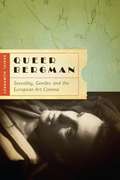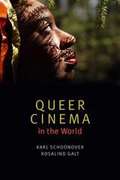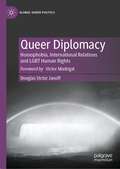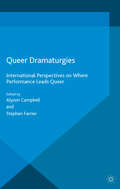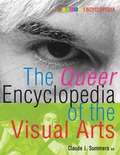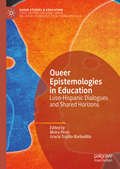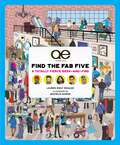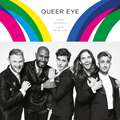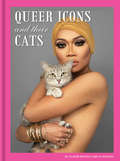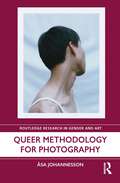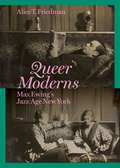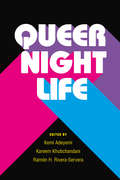- Table View
- List View
Queer Bergman: Sexuality, Gender, and the European Art Cinema
by Daniel HumphreyOne of the twentieth century's most important filmmakers--indeed one of its most important and influential artists--Ingmar Bergman and his films have been examined from almost every possible perspective, including their remarkable portrayals of women and their searing dramatizations of gender dynamics. Curiously however, especially considering the Swedish filmmaker's numerous and intriguing comments on the subject, no study has focused on the undeniably queer characteristics present throughout this nominally straight auteur's body of work; indeed, they have barely been noted. Queer Bergman makes a bold and convincing argument that Ingmar Bergman's work can best be thought of as profoundly queer in nature. Using persuasive historical evidence, including Bergman's own on-the-record (though stubbornly ignored) remarks alluding to his own homosexual identifications, as well as the discourse of queer theory, Daniel Humphrey brings into focus the director's radical denunciation of heteronormative values, his savage and darkly humorous deconstructions of gender roles, and his work's trenchant, if also deeply conflicted, attacks on homophobically constructed forms of patriarchic authority. Adding an important chapter to the current discourse on GLBT/queer historiography, Humphrey also explores the unaddressed historical connections between post-World War II American queer culture and a concurrently vibrant European art cinema, proving that particular interrelationship to be as profound as the better documented associations between gay men and Hollywood musicals, queer spectators and the horror film, lesbians and gothic fiction, and others.
Queer Cinema in the World
by Rosalind Galt Karl SchoonoverProposing a radical vision of cinema's queer globalism, Karl Schoonover and Rosalind Galt explore how queer filmmaking intersects with international sexual cultures, geopolitics, and aesthetics to disrupt dominant modes of world making. Whether in its exploration of queer cinematic temporality, the paradox of the queer popular, or the deviant ecologies of the queer pastoral, Schoonover and Galt reimagine the scope of queer film studies. The authors move beyond the gay art cinema canon to consider a broad range of films from Chinese lesbian drama and Swedish genderqueer documentary to Bangladeshi melodrama and Bolivian activist video. Schoonover and Galt make a case for the centrality of queerness in cinema and trace how queer cinema circulates around the globe-institutionally via film festivals, online consumption, and human rights campaigns, but also affectively in the production of a queer sensorium. In this account, cinema creates a uniquely potent mode of queer worldliness, one that disrupts normative ways of being in the world and forges revised modes of belonging.
Queer Cinema: Schoolgirls, Vampires, and Gay Cowboys
by Barbara MennelQueer Cinema: Schoolgirls, Vampires, and Gay Cowboys illustrates queer cinematic aesthetics by highlighting key films that emerged at historical turning points throughout the twentieth century. The book traces the representation of gays and lesbians from the sexual liberation movements of the roaring 1920s in Berlin to the Stonewall Rebellion in New York City and the emergence of queer activism and film in the early 1990s. The book explains early tropes of queerness, such as the boarding school or the vampire, and describes the development of camp from 1950s Hollywood to underground art of the late 1960s in New York City. It concludes with an exploration of the contemporary mainstreaming of gay and lesbian films and global queer cinema. Queer Cinema: Schoolgirls, Vampires and Gay Cowboys thus offers an introduction to a gay and lesbian film history, but also contributes to an academic discussion about queer subversion of mainstream film.
Queer Cinema: Schoolgirls, Vampires, and Gay Cowboys (Short Cuts)
by Barbara MennelQueer Cinema: Schoolgirls, Vampires, and Gay Cowboys illustrates queer cinematic aesthetics by highlighting key films that emerged at historical turning points throughout the twentieth century. Barbara Mennel traces the representation of gays and lesbians from the sexual liberation movements of the roaring 1920s in Berlin to the Stonewall Rebellion in New York City and the emergence of queer activism and film in the early 1990s. She explains early tropes of queerness, such as the boarding school or the vampire, and describes the development of camp from 1950s Hollywood to underground art of the late 1960s in New York City. Mennel concludes with an exploration of the contemporary mainstreaming of gay and lesbian films and global queer cinema. Queer Cinema: Schoolgirls, Vampires and Gay Cowboys not only offers an introduction to a gay and lesbian film history, but also contributes to an academic discussion about queer subversion of mainstream film.
Queer Difficulty in Art and Poetry: Rethinking the Sexed Body in Verse and Visual Culture
by Christopher Reed Jongwoo Jeremy KimAugmenting recent developments in theories of gender and sexuality, this anthology marks a compelling new phase in queer scholarship. Navigating notions of silence, misunderstanding, pleasure, and even affects of phobia in artworks and texts, the essays in this volume propose new and surprising ways of understanding the difficulty—even failure—of the epistemology of the closet. By treating "queer" not as an identity but as an activity, this book represents a divergence from previous approaches associated with Lesbian and Gay Studies. The authors in this anthology refute the interpretive ease of binaries such as "out" versus "closeted" and "gay" versus "straight," and recognize a more opaque relationship of identity to pleasure. The essays range in focus from photography, painting, and film to poetry, Biblical texts, lesbian humor, and even botany. Evaluating the most recent critical theories and introducing them in close examinations of objects and texts, this book queers the study of verse and visual culture in new and exciting ways.
Queer Diplomacy: Homophobia, International Relations and LGBT Human Rights (Global Queer Politics)
by Douglas Victor JanoffThis book is the first study of multilateral LGBT human rights diplomacy viewed from the perspective of its practitioners: diplomats, LGBT activists, human rights experts and multilateral specialists. It demonstrates how diplomats and advocates work to promote LGBT rights on the world stage, often using Western constructs of sexual and gender identity. In turn, these efforts have triggered conflict and polarization: opposing states often deploy cultural, religious and moral discourses to minimize LGBT rights as a “legitimate” human right. The author, a seasoned Canadian foreign service officer, human rights negotiator and former community activist and researcher, uses insider perspectives to critically assess both bilateral and multilateral diplomatic engagement on LGBT human rights issues. Janoff’s research involved participation in UN meetings in Geneva and New York and 29 interviews with diplomats, human rights advocates and experts, and representatives from the UN and other inter-governmental organizations. Although LGBT issues have been mainstreamed into many areas of bilateral and multilateral human rights policy, his research found a considerable gap: a coordinated diplomatic and civil society approach is needed to more effectively address ongoing human rights violations against LGBT people around the world.
Queer Dramaturgies: International Perspectives on Where Performance Leads Queer (Contemporary Performance InterActions)
by Alyson Campbell Stephen FarrierThis international collection of essays forms a vibrant picture of the scope and diversity of contemporary queer performance. Ranging across cabaret, performance art, the performativity of film, drag and script-based theatre it unravels the dynamic relationship performance has with queerness as it is presented in local and transnational contexts.
Queer Dramaturgies: International Perspectives on Where Performance Leads Queer (Contemporary Performance InterActions)
by Alyson Campbell Stephen FarrierThis international collection of essays forms a vibrant picture of the scope and diversity of contemporary queer performance. Ranging across cabaret, performance art, the performativity of film, drag and script-based theatre it unravels the dynamic relationship performance has with queerness as it is presented in local and transnational contexts.
Queer Encyclopedia of Film and Television
by Claude J. SummersFrom Hollywood films to TV soap operas, from Vegas extravaganzas to Broadway theater to haute couture, this comprehensive encyclopedia contains over 200 entries and 200 photos that document the irrepressible impact of queer creative artists on popular culture.How did Liberace&’s costumes almost kill him? Which lesbian comedian spent her high school years as &“the best white cheerleader in Detroit?&” For these answers and more, fans can dip into The Queer Encyclopedia of Film, Theater, and Popular Culture. Drawn from the fascinating online encyclopedia of queer arts and culture, www.glbtq.com — which the Advocate dubbed &“the Encyclopedia Brittaniqueer&” — this may be the only reference book in which RuPaul and Jean Cocteau jostle for space. From the porn industry to the Sisters of Perpetual Indulgence, from bodybuilding to Dorothy Arzner, it&’s a queer, queer world, and The Queer Encyclopedia is the indispensable guide: readable, authoritative, and concise. And perfect to read by candelabra. (The answers to the two questions above: from the dry cleaning fumes, Lily Tomlin.)
Queer Encyclopedia of Music, Dance, and Musical Theater
by Claude J. SummersAficionados of music, dance, opera, and musical theater will relish this volume featuring over 200 articles showcasing composers, singers, musicians, dancers, and choreographers across eras and styles.Read about Hildegard of Bingen, whose Symphonia expressed both spiritual and physical desire for the Virgin Mary, and George Frideric Handel, who not only created roles for castrati but was behind the Venetian opera's preoccupations with gender ambiguity. Discover Alban Berg&’s Lulu, opera&’s first openly lesbian character. And don&’t forget Kiss Me Kate, the hit 1948 Broadway musical: written by Cole Porter, married though openly gay; directed by John C. Wilson, Noël Coward's ex-lover; and featuring Harold Lang, who had affairs with Leonard Bernstein and Gore Vidal.No single volume has ever achieved the breadth of this scholarly yet eminently readable compendium. It includes overviews of genres as well as fascinating biographical entries on hundreds of figures such as Peter Tchaikovsky, Maurice Ravel, Sergei Diaghilev, Bessie Smith, Aaron Copland, Stephen Sondheim, Alvin Ailey, Rufus Wainwright, and Ani DiFranco.
Queer Encyclopedia of the Visual Arts
by Claude J. SummersA distinctly queer presence permeates the history of the visual arts — from Michelangelo's David and homoerotic images on ancient Greek vases to Frida Kahlo's self-portraits and the photography of Claude Cahun and Robert Mapplethorpe. The Queer Encyclopedia of the Visual Arts is a comprehensive work showcasing the enormous contribution of gay, lesbian, bisexual, transgender, and queer artists to painting, drawing, photography, printmaking, sculpture, and architecture.International in scope, the volume includes overviews of the various periods in art history, from Classical Art to Contemporary Art and from African Art to Erotic and Pornographic Art; discussions of topics ranging from AIDS Activism in the Arts, Censorship in the Arts, and the Arts and Crafts Movement to Pulp Paperbacks and Their Covers; surveys of the representation of various subjects in the visual arts, from Androgyny to Vampires; and biographical entries on significant figures in the history of art, such as Andy Warhol, Keith Haring, El Greco, Leonardo da Vinci, David Hockney, Ruth Bernhard, Rosa Bonheur, Romaine Brooks, Simeon Solomon, and Nahum Zenil. Includes more than 100 illustrations and photographs.
Queer Epistemologies in Education: Luso-Hispanic Dialogues and Shared Horizons (Queer Studies and Education)
by Moira Pérez Gracia Trujillo-BarbadilloThis edited collection brings together the work of researchers and educators from Argentina, Brazil, Spain, Colombia, Costa Rica, Portugal,and Mexico on education, pedagogy, and research from a queer perspective. It offers a space for the dissemination and development of new lines of analysis and intervention in the field of Queer Pedagogies in the region, relevant to the present and future of the field both in our countries and beyond. Chapters provide perspectives aware of the regional context but relevant from a theoretical and practical perspective beyond Ibero-America. The volume covers elementary, middle, and higher education, formal and informal, and includes theoretical and applied contributions on a variety of topics including public policies on education, queer youth, sex education, and conservative attacks against "gender ideology" in the region.
Queer Eye: A Totally Fierce Seek-and-Find
by Lauren Emily WhalenWhere's the Fab Five? At a pride parade? Remodeling a house? At a thrift shop? Find all five members of the cast of Queer Eye—plus Neon the dog and additional hidden items—in more than a dozen unique settings within this original and officially licensed search-and-find activity book. Search for the beloved cast of Queer Eye—plus Antoni&’s adorable pooch, Neon—in more than a dozen fun settings within this original officially licensed search-and-find activity book inspired by the Fab Five and their unique areas of expertise. This book also invites you to look for additional items and accessories within each fully illustrated scene. Can you spot JVN&’s missing heel? How about Antoni&’s bandana? Good luck, queen! © 2023 Scout Productions, Inc. All Rights Reserved.
Queer Eye: Love Yourself, Love Your Life
by Antoni Porowski Tan France Jonathan Van Ness Bobby Berk Karamo BrownFrom the Fab Five - the beloved hosts of Netflix's viral hit Queer Eye - comes a book, and an official guide, that is at once a behind-the-scenes exclusive, a practical guide to living and celebrating your best life, and a symbol of hope.Feeling your best is about far more than deciding what colour to paint your accent wall or how to apply nightly moisturiser. It's also about creating a life that's well-rounded, filled with humour and understanding and most importantly, that suits you. At a cultural moment when we are all craving people to admire, Queer Eye offers hope and acceptance. After you get to know the Fab Five, together they will guide you through five practical chapters that go beyond their designated areas of expertise (food & wine, fashion, grooming, home decor, and culture), touching on topics like wellness, entertaining, and defining your personal brand, and complete with bite-sized Hip Tips for your everyday quandaries. Above all else, Queer Eye aims to help you create a happy and healthy life, rooted in self-love and authenticity.
Queer Eye: Love Yourself, Love Your Life
by Antoni Porowski Tan France Jonathan Van Ness Bobby Berk Karamo BrownFrom the Fab Five - the beloved hosts of Netflix's viral hit Queer Eye - comes a book, and an official guide, that is at once a behind-the-scenes exclusive, a practical guide to living and celebrating your best life, and a symbol of hope.Feeling your best is about far more than deciding what colour to paint your accent wall or how to apply nightly moisturiser. It's also about creating a life that's well-rounded, filled with humour and understanding and most importantly, that suits you. At a cultural moment when we are all craving people to admire, Queer Eye offers hope and acceptance. After you get to know the Fab Five, together they will guide you through five practical chapters that go beyond their designated areas of expertise (food & wine, fashion, grooming, home decor, and culture), touching on topics like wellness, entertaining, and defining your personal brand, and complete with bite-sized Hip Tips for your everyday quandaries. Above all else, Queer Eye aims to help you create a happy and healthy life, rooted in self-love and authenticity.(P)2018 Random House Audio, LLC
Queer Girls, Temporality and Screen Media
by Whitney MonaghanThis book takes up the queer girl as a represented and rhetorical figure within film, television and video. In 1987, Canada's Degrassi Junior High featured one of TV's first queer teen storylines. Contained to a single episode, it was promptly forgotten within both the series and popular culture more generally. Cut to 2016 - queer girls are now major characters in films and television series around the globe. No longer represented as subsidiary characters within forgettable storylines, queer girls are a regular feature of contemporary screen media. Analysing the terms of this newfound visibility, Whitney Monaghan provides a critical perspective on this, arguing that a temporal logic underpins many representations of queer girlhood. Examining an archive of screen texts that includes teen television series and teenpics, art-house, queer and independent cinemas as well as new forms of digital video, she expands current discourse on both queer representation and girls' studies by looking at sexuality through themes of temporality. This book, the first full-length study of its kind, draws on concepts of boredom, nostalgia and transience to offer a new perspective on queer representation in contemporary screen media.
Queer Icons and Their Cats
by Alison Nastasi PJ NastasiThese cat lovers are out and purr-oud!Freddie Mercury, Sylvia Rivera, Alison Bechdel, Dusty Springfield. This book is a celebration of queer icons of the past and present and their furry feline friends. From images of lost legends such as Josephine Baker and James Baldwin, to snapshots of contemporary trailblazers like comedian Tig Notaro and fashion designer Jason Wu—these charming and eccentric photographs capture what it truly means to be a cat purr-son.• PURR-FECT FOR CAT LOVERS: This book celebrates the love between human and cat. What better gift could you get the feline fancier in your life?• AMEWSING ANECDOTES AND IMPAWTENT MOMENTS: Learn about the lives of the queer heroes who came before us and those who are still fighting for equality and inclusion. We're not kitten around—with watershed moments like the Stonewall riots and sweet stories of domestic bliss, this book will both entertain and inspire you.• PHOTOS WITH CATITUDE: In these purr-ecious photographs, you'll get to see your heroes in unguarded moments expressing love for their pets. This collection of images will bring joy to any cat lover's heart.Perfect for: • LGBTQIA+ cat lovers and the people who shop for them• Anyone interested in learning more about influential queer figures—and their pets!
Queer Imaginings: On Writing and Cinematic Friendship (Queer Screens)
by David A. GerstnerHow do we identify the "queer auteur" and their queer imaginings? Is it possible to account for such a figure when the very terms "queer" and "auteur" invoke aesthetic surprises and disorientations, disconcerting ironies and paradoxes, and biographical deceits and ambiguities? In eighteen eloquent chapters, David A. Gerstner traces a history of ideas that spotlight an ever-shifting terrain associated with auteur theory and, in particular, queer-auteur theory. Engaging with the likes of Oscar Wilde, Walter Benjamin, James Baldwin, Jean Louis Baudry, Linda Nochlin, Jane Gallop, Cáel Keegan, Luce Irigaray, and other prominent critical thinkers, Gerstner contemplates how the queer auteur in film theory might open us to the work of desire. Queer Imaginings argues for a queer-auteur in which critical theory is reenabled to reconceptualize the auteur in relation to race, gender, sexuality, and desire. Gerstner succinctly defines the contours of a history and the ongoing discussions that situate queer and auteur theories in film studies. Ultimately, Queer Imaginings is a journey in shared pleasures in which writing for and about cinema makes way for unanticipated cinematic friendships.
Queer Issues in Contemporary Latin American Cinema
by David William FosterViewing contemporary Latin American films through the lens of queer studies reveals that many filmmakers are exploring issues of gender identity and sexual difference, as well as the homophobia that attempts to defeat any challenge to the heterosexual norms of patriarchal culture.<P><P> In this study of queer issues in Latin American cinema, David William Foster offers highly perceptive queer readings of fourteen key films to demonstrate how these cultural products promote the principles of an antiheterosexist stance while they simultaneously disclose how homophobia enforces the norms of heterosexuality. <P> Foster examines each film in terms of the ideology of its narrative discourse, whether homoerotic desire or a critique of patriarchal heterosexism and its implications for Latin American social life and human rights. His analyses underscore the difficulties involved in constructing a coherent and convincing treatment of the complex issues involved in critiquing the patriarchy from perspectives associated with queer studies. The book will be essential reading for everyone working in queer studies and film studies.
Queer Love in Color
by Jamal JordanA photographic celebration of the love and relationships of queer people of color by a former New York Times multimedia journalist&“Thank you, Jamal Jordan, for showing the world what true love looks like.&”—Billy PorterQueer Love in Color features photographs and stories of couples and families across the United States and around the world. This singular, moving collection offers an intimate look at what it means to live at the intersections of queer and POC identities today, and honors an inclusive vision of love, affection, and family across the spectrum of gender, race, and age.
Queer Methodology for Photography (Routledge Research in Gender and Art)
by Asa JohannessonThis book presents new ways of approaching photographic discourse from a queer perspective, offering discussions on what a queering methodology for photography may entail by drawing links between artistic strategies in photographic practice and key theoretical concepts from photography theory, queer theory, critical theory, and philosophy. With different examples of conceptual perspectives, including representation, formalism, and mediumlessness, it seeks to diversify queer methodology for photography. While primarily addressing photography, this book is entwined with broader philosophical questions concerning identity, difference, and the creations of systems of thought that limit the possibilities of existence to binary categorisation. It proposes a new concept of the photographic image that addresses its materiality, in the form of the poetic and the political, in relationship to a generative principle that is named as a queer quality: the photograph’s ability to voice queer concerns also beyond its role as representation. This book will be of interest to scholars working in photography, art history, queer studies, new materialism, and posthumanism.
Queer Mexico: Cinema and Television since 2000
by Paul Julian SmithQueer Mexico: Cinema and Television since 2000 provides critical analysis of both mainstream and independent audiovisual works, many of them little known, produced in Mexico since the turn of the twenty-first century. In the book, author Paul Julian Smith aims to tease out the symbiotic relationship between culture and queerness in Mexico. Smith begins with the year 2000 because of the political shift that happened within the government—the Institutional Revolutionary Party (PRI) was voted out of national office after over seventy years in power. Judicial and social changes for LGBT Mexicans came in the wake of what was known at the time as simply “the change” (“el cambio”) at the start of the millennium, bringing about an increased visibility and acknowledgment of the LGBT community. Divided into five chapters, Queer Mexico demonstrates the diversity of both representation and production processes in the Mexican film and television industry. It attempts also to reconstruct a queer cultural field for Mexico that incorporates multiple genres and techniques. The first chapter looks at LGBT festivals, porn production, and a web-distributed youth drama, claimed by its makers to be the first wholly gay series made in Mexico. The second chapter examines selected features and shorts by Mexico’s sole internationally distributed art house director, Julián Hernández. The third chapter explores the rising genre of documentary on transgender themes. The fourth chapter charts the growing trend of a gay, lesbian, or trans-focused mainstream cinema. The final chapter addresses the rich and diverse history of queer representation in Mexico’s dominant television genre and, arguably, national narrative: the telenovela. The book also includes an extensive interview with gay auteur Julián Hernández. The first book to come out of the Queer Screens series (a sub-series of the Contemporary Approaches to Film and Media series), Queer Mexico is a groundbreaking monograph for anyone interested in media or LGBT studies, especially as it relates to the culture of Latin America.
Queer Moderns: Max Ewing's Jazz Age New York
by Alice T. FriedmanA richly illustrated history of the glittering world of queer artistic life in the 1920s and &’30sIn Queer Moderns, Alice Friedman tells the fascinating story of the queer avant-garde of the 1920s and &’30s in New York, Paris, and Venice, as seen through the eyes of Max Ewing (1903–1934), a young musician, photographer, and man-about-town who, although virtually unknown today, moved in extraordinary circles. In his photographs and letters, we meet the rising stars of modern art, music, dance, and literature and enter a world of interracial friendship, &“queer space,&” and experimentation that shone brightly before being swept away by the Depression. It is a remarkable story that reveals that the history of modernism is more queer and more Black than previously recognized.In the 1920s, Ewing became part of an international coterie of artists led by Carl Van Vechten and Muriel Draper. In Europe, he was entertained by Gertrude Stein, met Stravinsky, and took a road trip with Romaine Brooks and Natalie Barney. In 1928, in a closet in his apartment, Ewing created the Gallery of Extraordinary Portraits, an installation of photos of his favorite celebrities—Black and white, clothed and nude. For his Carnival of Venice, he took portraits of more than a hundred friends—including Paul Robeson, Berenice Abbott, Isamu Noguchi, Agnes de Mille, and E. E. Cummings—posed in front of a backdrop of Saint Mark&’s Square.Like a character from a story by F. Scott Fitzgerald, Ewing joined the party and then died tragically, unable to accept the end of his era or the lost dream of a new way of living. His story sheds new light on modernism and an artistic milieu that was ahead of its time.
Queer Networks: Ray Johnson's Correspondence Art
by Miriam KienleHow the queer correspondence art of Ray Johnson disrupted art world conventions and anticipated today&’s highly networked culture Once regarded as &“New York&’s most famous unknown artist,&” Ray Johnson was a highly visible outlier in the art world, his mail art practice reflecting the changing social relations and politics of queer communities in the 1960s. A vital contribution to the growing scholarship on this enigmatic artist, Queer Networks analyzes how Johnson&’s practice sought to undermine the dominant mechanisms of the art market and gallery system in favor of unconventional social connections. Utilizing the postal service as his primary means of producing and circulating art, Johnson cultivated an international community of friends and collaborators through which he advanced his idiosyncratic body of work. Applying both queer theory and network studies, Miriam Kienle explores how Johnson&’s radical correspondence art established new modes of connectivity that fostered queer sensibilities and ran counter to the conventional methods by which artists were expected to develop their reputation. 
Queer Nightlife (Triangulations: Lesbian/Gay/Queer Theater/Drama/Performance)
by Ramon Rivera-Servera Kareem Khubchandani Kemi AdeyemiThe mass shooting at a queer Latin Night in Orlando in July 2016 sparked a public conversation about access to pleasure and selfhood within conditions of colonization, violence, and negation. Queer Nightlife joins this conversation by centering queer and trans people of color who apprehend the risky medium of the night to explore, know, and stage their bodies, genders, and sexualities in the face of systemic and social negation. The book focuses on house parties, nightclubs, and bars that offer improvisatory conditions and possibilities for “stranger intimacies,” and that privilege music, dance, and sexual/gender expressions. Queer Nightlife extends the breadth of research on “everynight life” through twenty-five essays and interviews by leading scholars and artists. The book’s four sections move temporally from preparing for the night (how do DJs source their sounds, what does it take to travel there, who promotes nightlife, what do people wear?); to the socialities of nightclubs (how are social dance practices introduced and taught, how is the price for sex negotiated, what styles do people adopt to feel and present as desirable?); to the staging and spectacle of the night (how do drag artists confound and celebrate gender, how are spaces designed to create the sensation of spectacularity, whose bodies become a spectacle already?); and finally, how the night continues beyond the club and after sunrise (what kinds of intimacies and gestures remain, how do we go back to the club after Orlando?).
